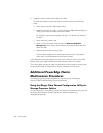
support.dell.com Index 3
PowerEdge clusters
about, 1-2
active/active configurations, 1-5
active/passive configurations, 1-5
adding cluster peripherals, 3-1
additional maintenance procedures,
10-8
attaching one cluster to one
PoweVault storage system, 10-6
configuring enclosure addresses, 3-2
configuring Fibre Channel HBAs, 3-2
preparing for clustering, 3-1
SAN-attached cluster configurations,
1-3
SAN-attached clusters
attaching a PowerVault storage
system, 10-6
upgrading to a FE100/FL100
configuration requirements, 1-13
PowerEdge system
upgrading to a FE100/FL100
Datacenter Server configuration,
8-1
PowerEdge systems
about Windows 2000 platforms, 8-2
upgrading to a cluster configuration, 8-
1
upgrading to a FE100/FL100
Datacenter Server configuration,
8-1
PowerVault 65xF storage system
replacing the storage processor, 9-4
PowerVault storage area network (SAN)
about, 10-1
PowerVault storage systems
adding to cluster, 3-1
configuring enclosure addresses, 3-2
configuring Fibre Channel HBAs, 3-2
connecting a tape library and bridge to
a cluster-attached PowerVault
SAN, 10-7
low-level configurations, 5-1
preparing for clustering, 3-1
shared storage requirements, 1-14
private network
cabling, 4-3
configuring the IP addresses, 6-5
configuring using Windows 2000, 6-4
hardware components, 1-11
using Broadcom Gigabit NICs, 4-3
using cLAN Giganet, 4-4
verifying cluster readiness, 6-15
verifying Cluster Service, 6-15
public network
cabling, 4-3
hardware components, 1-12
using NICs, 4-3
verifying cluster readiness, 6-15
verifying cluster resource availability,
6-15
verifying Cluster Service, 6-15
Q
QLConfig
about, 9-4
replacing the PowerVault 65xF storage
processor, 9-4
R
racks
cabling your mouse, keyboard, and
monitor, 4-6
replacing a cluster node, 9-8
S
SAN-attached cluster configuraitons
hardware requirements, 1-15
SAN-attached cluster configurations, 1-3
attaching a PowerVault storage
system, 10-6
storage processor failure
recovery procedures, 9-4


















